SaaS Content Marketing
10 mins read
A Newbie’s Pathway to Crafting Engaging SaaS Content
New to SaaS content writing? Here, I share how I went from newbie to a Product-Led Storyteller now crafting engaging SaaS content pieces that works.
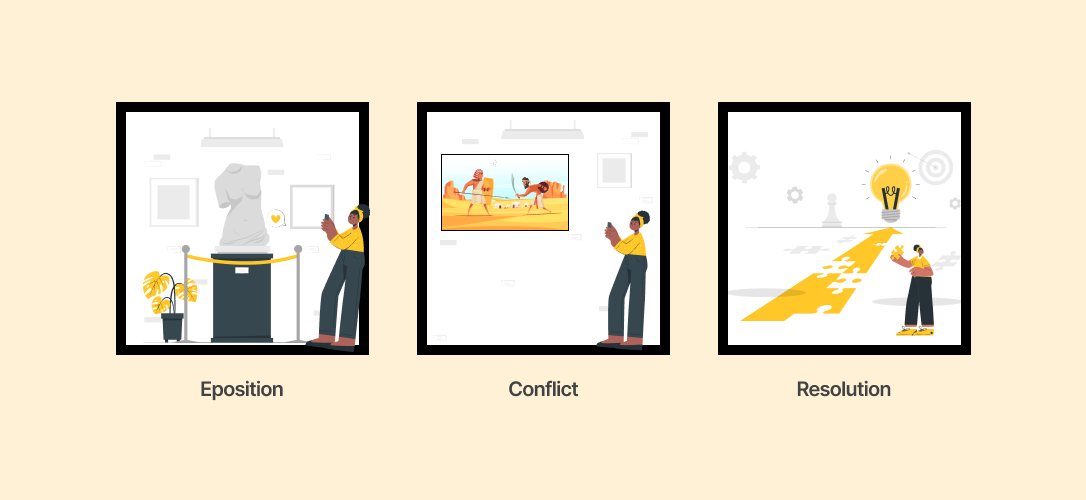

Ubelejit Dandison
After over two months of writing and rewriting the first training piece, here was the feedback:
“I don’t know where to place this article but I see you’ve improved on your research.”
She took the good part of what was a demoralizing feedback –that her research skills had improved– and ran with that. It was the fuel that propelled her to her eureka moment you’d soon find out.
Few months down the line, she got another feedback on her second and third training pieces in a meeting and it sounded like this:
“…her ideas are original and it shows she’s been reading.”
This one feedback boosted her confidence. Indeed she could find her voice in this crowded space called SaaS content marketing.
That was me in the trainee’s shoes.
And that’s where most in-house writers and freelancers new to SaaS content marketing are. For many of us, we’re at the place of discovering our unique voices and differentiating ourselves from the millions of marketers, constituting a population of over 500 million active blogs.
Overwhelming isn’t it?
A whopping 500 million active blogs and reportedly 7.5 million blog posts published daily. Believe me, I know what it means to feel like you came to the party unprepared:
But with consistent practice, preparation, and feeding on the right resources, I overcame that feeling of oddness and now craft content with confidence, knowing readers like you will get immense value.
And that’s where this piece comes in.
I’ll share how I went from newbie writer to a Product-Led Storyteller who now crafts engaging stories with confidence. What’s more? I’ll also point you to some resources that’ll help you too.

What I’ll Cover
Conversation, Where it All Begins
SaaS content writing is nothing official like the name SaaS. It’s also not near anything like giving an end of year financial account report.
It’s best to approach it like having a conversation with a friend.
Another problem I had as a newbie writer was the eagerness to drive sales and justify my salary. Now don’t get me wrong. Every content marketing piece should ultimately make sales easier, and I’ll come to that. But excessive obsession with driving sales means you’ll be putting so much effort into writing a cozy copy with the hopes of closing a lead.
I now know better.
Customers are no longer ignorant. In fact, they know some bits of copywriting and can tell when you’re fooling around.
People want to feel the human voice behind your written words. They want you to talk to them (like I’m doing my best to talk to you here), show you truly care, and can provide the solution they need.
Customers want answers, so the ultimate goal of your SaaS content pieces should be to answer their queries. The more humane you are in doing so via your words, the easier it is to connect with them.
That’s the basis of prioritizing a conversational tone when writing. Dave Gerhardt, Drift’s former VP of Marketing, said it best when talking about Conversational Marketing, a term he helped coin:
“It’s all about making something easier to remember, and creating real-estate in somebody’s mind.”
Drift created Conversational Marketing to connect customers and their products through conversations, and it worked wonders. It worked because they understood the importance of having a relationship with customers.
Your written SaaS content should do the same. Aim to converse, relate, and speak in a simple, humane language.
It’s what great marketing should do, care first before selling.
Anthony Iannarino, Expert Writer & Salesman, was right when he said:
“It’s about caring enough to create value for customers. If you get that part right, selling is easy.”
Your ability to consume complex details and break them down into simple, conversational bits makes you relatable and often stand out.
To get here, I dumped all the pressure from that proud voice in my head telling me to sound like an expert. I now strive to lead an actual conversation, and you shouldn’t do otherwise.
Well, sit tight because how I got here is what I’m discussing next.
The 3 Elements Helping Me Excel At SaaS Content Writing
It’s one thing to create content and it’s another thing to create content people really engage with, consume, and take favorable business actions.
If you’re familiar with the VEC brand, you may be wondering: How do these guys craft content compelling clients to say things like:
Below are three things helping me (and the VEC team) excel at SaaS writing to earn testimonials like the one above.
Story: How to Use it in B2B Marketing
There are childhood memories and stories I still hold onto.
A significant one is when my Dad told me a story one cool evening as he sat bare-chested with only a wrapper tied firmly around his loins (yeah, Nigerian dads dress like that).
He shared his encounter with an apparition on his way to school as a child and I couldn’t help but stay stunned for days. Maybe years.
Call it a fairytale or not but it’s stuck to my brain.
I can bet you too have one childhood memory or story you still remember and hold onto.
You know why?
Because that’s what stories do when you tell them well.
“Humans have built into their brains the capacity to use stories to remember things they care about.”
Those were words by Global Bestselling author, Shane Snow, in a Business Storytelling Podcast.
He went on to say:
“The story is the vehicle that would often get people to care about what you have to say.”
As observed by Shane, storytelling helps you stir up emotions from readers. But more importantly is how you tell it when it comes to B2B marketing.
And that brings me to a challenge I had earlier in my career:
How do I use storytelling in my B2B content marketing pieces?
Storytelling in B2B marketing doesn’t connote actual fiction though it can work if used intelligently.
Anything can inspire a story: What a speaker said at a seminar, statistics you came across, a book you read, a movie you watched, a product’s founding story, customer testimonial, or user case study.
It could spring from any idea.
But it’ll only come to life when you tell it in a way that drives empathy from the reader and make them feel like they are in the story. Strive to make your target audience see that you understand where it hurts and can relate to their pain. And, that you know what they need by providing answers via your content.
Ann Handley reiterated this in her book “Everybody Writes:”
“Your story might be about you but it should always be told in the context of your customer’s life…The best content has your customers in it, so make sure your customer is the hero of your story. Even if you sell something that some might consider inherently boring, like technology, or toasters, focus on how your products or services touch people’s lives, or why people should care about them.”
I’ll highlight this again because it couldn’t be said any better:
“…make sure your customer is the hero of your story.”
In other words, show how the hero goes through hurdles and be the guide they need to come out of that hurdle using the solutions shared in your content.
In fiction, this follows a story arc: Exposition, conflict, and resolution. This concept also applies to B2B storytelling:
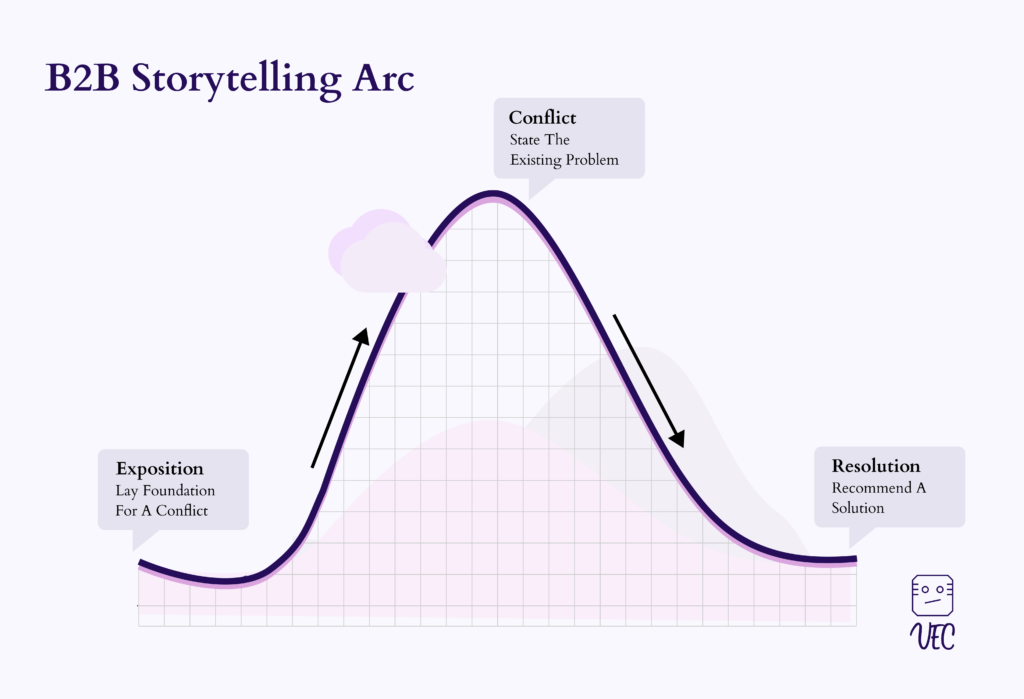
Exposition: Where does it all start? Lay your foundation for a conflict.
Conflict: What’s the existing problem?
Resolution: How do you resolve this problem for your reader? What recommended solution can you share in your content?
Like you, I struggled to apply this storytelling concept to my B2B writing until I saw this piece by Animalz on how to write an introduction.
The blog ended up being more than how to write an introduction for me.
Instead, my eureka moment was seeing how Gail Marie told the story of Alfred Dean, an angler, and anchored on it as the base for the entire piece:
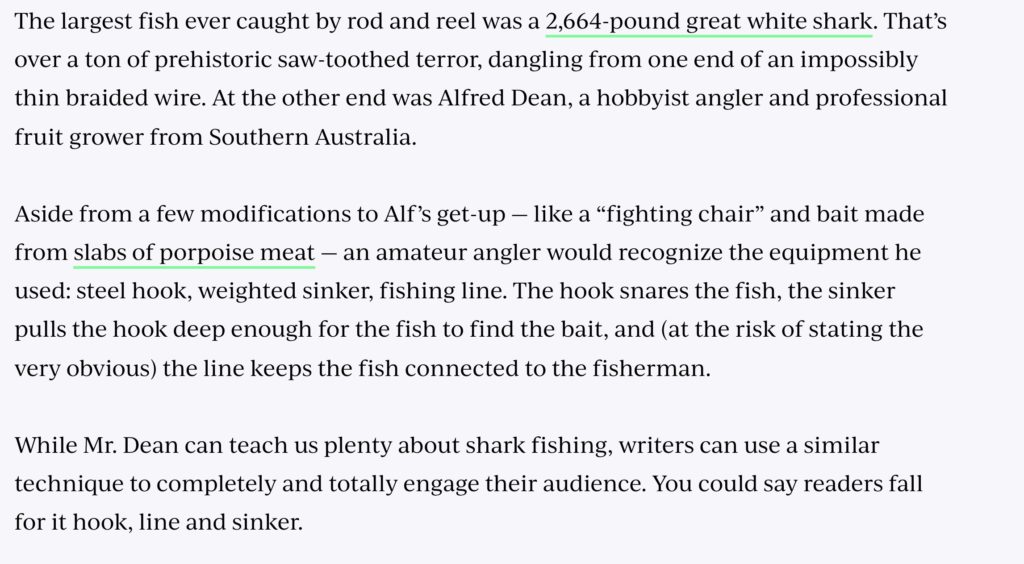
She even gave it a funky title, “Hook, Line, Sinker…”
It lit a bulb in my head and set an example of the many things that could happen with storytelling in a B2B marketing piece.
But mind you, B2B storytelling is no fairytale so don’t beat about the bush.
You are using its prowess as a channel to drive home a point, as I have done in this piece. Drive home the point and don’t paint a Cinderella scenario for your readers.
If prospects want a literal story blog, they know where to find one.
Style
Style is how you want an ideal reader to perceive your writing.
It’s the reason you can differentiate one writer from another. It’s also the reason you are endeared to your favorite writer.
On the subject of style, I love how Ann Handley puts it:
“Know who you are and who you don’t want to be.”
Follow this golden advice by Ann, and it’ll set you apart.
As a freelancer or an in-house content writer, chances are that you’d work on different client projects, which means you’d be bound by different company style guides. Regardless, there’s one secret to pulling the string.
Find your voice and know the feeling you want readers to have when (and after) reading your piece.
It would help you to tone down or adjust appropriately when necessary.
Are you uptight and professional, are you fun, easy-going, authoritative?
Finding and sticking to your voice describes your personality to your content readers and helps them relate with you better…
However, certain rules guide whatever style you choose:
- Communicate points with as few words as possible. Doing this helps the reader easily comprehend what you are saying.
- Write short paragraphs.
- Write in an active and not passive voice. This VEC’s
- Consider the tone for every piece of writing.
For example, the copy on a homepage or blog post will most likely differ from that on a ‘FAQ’ page. In the same light, tone also differs on the kind of content you are developing: White paper, battle card, normal blog post, a marketing stats report, etc.
Whatever the case is, own your style.
Know when to switch tones for appropriate scenarios but never think because it’s SaaS content writing, you’re bound to wear a suit and knot a tie.
Problem Solving Mindset
We’ve discussed two great elements, story and style.
While they are good refining techniques, nothing sets you apart than being a problem solver. Speaking in clear terms, applying storytelling techniques, and owning your voice are all vehicles to help you accomplish just one thing:
To solve a problem for your reader.
Victoria Willie, a Product-Led Storyteller here in VEC, captured it best with her definition of problem-solving content.
In her words:
“Problem-solving content marketing involves observing what’s going on with your target audience, identifying things that need improvement, diagnosing why they’re in their current state, and developing solutions to influence change for them:”
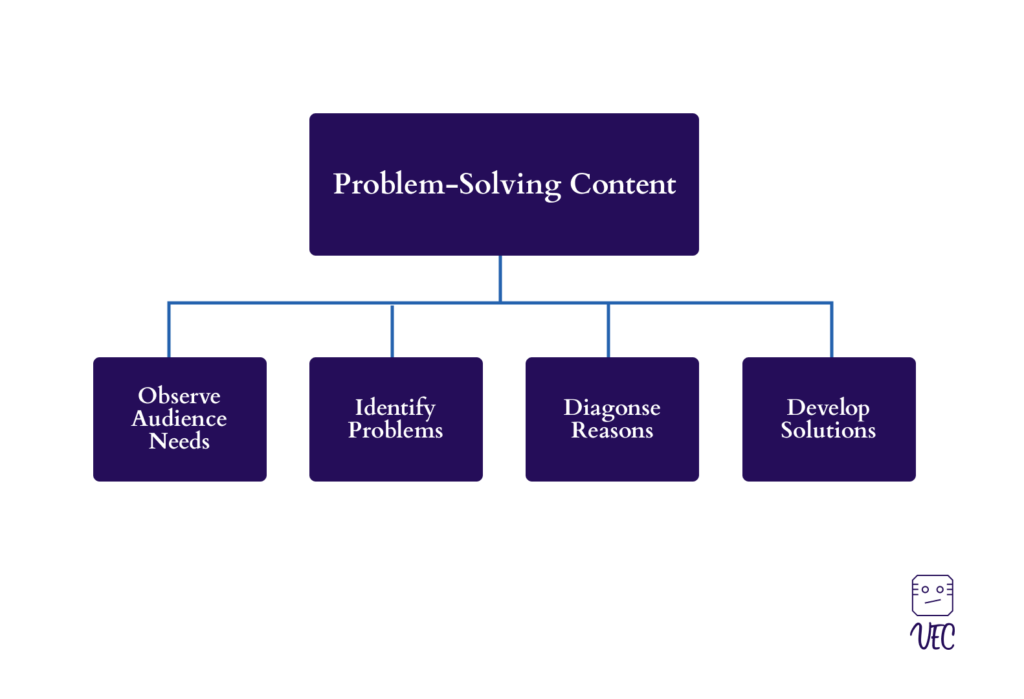
If your content fails at this, you’d only succeed in contributing to the content noise on the web. That’s something we kick against here at VEC, and it’s why our vision gears: “to make the web more valuable and useful, one story for one person at a time.”
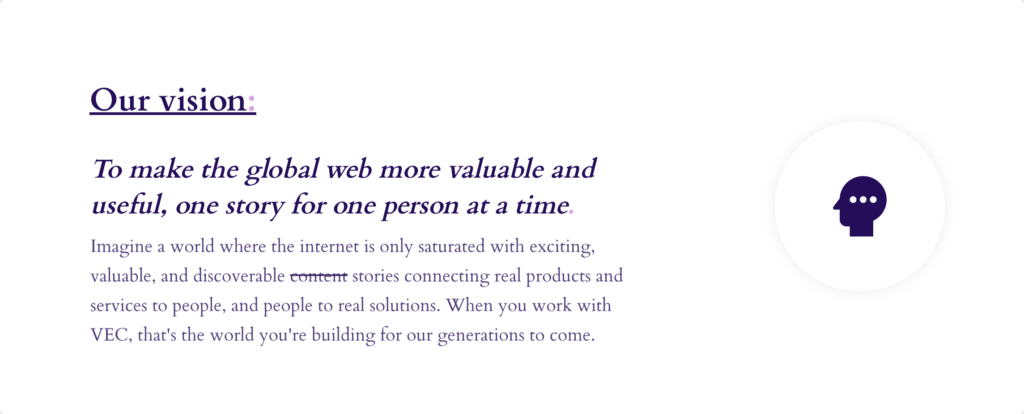
Two golden pieces of advice to take in if you are going to produce great content:
- Don’t create content for content sake
- See your content as an asset.
Riding on these two golden pieces of advice:
- Content should be created as a solution to an identified problem.
- Content overtime yields returns in terms of building authority and a community of loyal readers, easier customer acquisition, and retention.
Judging by research by Arbedeen, conversion rates are nearly 6 times higher for content marketing adopters than non-adopters.
Quite impressive if you ask me and a great nudge to do content marketing.
But, take your focus off conversion possibilities for a moment and think about the reason for the conversion.
It would look like this:
- Someone visits a website
- They get captivated by a valuable content piece
- They become a fan (keeps coming back)
- And eventually take action (Subscribes to your newsletter, signs up for a trial, or becomes an outright customer, etc) because each time they consume your content, it solves a problem for them.
All of these forms the basis of drafting your content with VEC’s Product-Led Storytelling approach (which I’ll come to in a bit):
Like ants naturally gravitate to sugar, in the same vein, people are bound to gather where there’s a solution to their pain.
So being that solution with each content piece you craft, by engaging and showing how readers can solve their problems, means a closer relationship between you and your readers.
And the reward for your efforts?
Conversion and recognition as an expert.
Reading.
There should be no cajoling you to do so.
It’s like saving money in a bank. When you make demands of it, it will bring benefits, but when there’s nothing in there, you’ll only hear a reverberating sound screaming “empty!”
The American children’s author, illustrator and filmmaker, Dr Seuss said:
“The more you read, the more things you’ll know. The more that you learn, the more places you’ll go.”
I read both marketing pieces and non-marketing pieces. I also read creative pieces: novels, short stories, watch documentaries, see movies, etc.
They have a way of opening your mind, giving you new perspectives and helping you connect with lessons that can be relevant to your next marketing piece. But more importantly, they make my work relatable and humane.
Subscribe to Newsletters
This is one way I stay updated with marketing insights and have a feel of how other marketers approach content writing. You may also get to dig into their marketing tactics from here.
Some good newsletters to start with are Dozie Anyaegbunam’s Efiko, Julian Shapiro’s letters, Letters by Fenwick Media, Animalz Newsletter, and VEC’s Product-Led Storytelling newsletter:
Follow Practical Industry Leaders
I used the word practical intentionally.
Check out industry leaders you can learn from, connect with them on Twitter or LinkedIn. Study their thought pattern. Some people I recommend are Jimmy Daly, Ross Simmonds, Chris Gellispe, Ryan Law, and VEC’s very own Victor Eduoh.
Besides industry leaders, connect with other content marketers who show promise of knowing their stuff.
Communities
Search for slack communities online and join industry-specific groups. This article should be of help. Quora and Reddit have useful communities you want to check out.
It may seem overwhelming to follow everything I’ve recommended above. But remember, you don’t have to do them all at once, it’s a progression, not an immediate landing. I’m still progressing too.
There’s one final part of my becoming a better SaaS writer…
I Learned to Tell Product-Led Stories
Today, I’m not just a SaaS content writer, I’m a Product-Led Storyteller.
“What the heck is that, you ask?”
Product-Led Storytelling.
A brainchild of the VEC brand, the Product-Led Storytelling approach helps you tell a product’s story in a way that shows how the product can solve a customer’s problem each time they consume your content.
It’s a content approach obsessed with crafting discoverable stories to attract, filter, and convert engaged readers directly into Product-Qualified Leads (PQLs). And that’s because they’ll see, in real-time as they consume your piece, how to solve their problems, irrespective of where they find your content:
It’s no empty talk. This method helps you reimagine the SaaS sales funnel, as you can see above.
Here’s proof that it’s working for us:

And our amazing customers:

I could go on and on.
Intriguing yeah?
That’s what I thought when I first came across this unique approach.
If you’re feeling like when I first learned this approach, check out the 9-step Product-Led Storytelling formula here.
Finally, I Constantly Strive to Differentiate Myself
Differentiating yourself from the many voices in SaaS content marketing isn’t by a spin of a magic wand.
It’s an everyday walk of growth and intentionality.
Your willingness to see every writing opportunity as a chance to provide practical answers to your readers’ problems must be at the core of everything you do.
It’s why I now see myself as not just a content marketer, but a solution provider.
There’s wisdom in these words by Mark Roberge:
“You know you are running a modern sales team when selling feels more like the relationship between a doctor and a patient and less like a relationship between a salesperson and a prospect… It’s no longer about interrupting, pitching and closing. It is about listening, diagnosing and prescribing.”
Writing engaging content is about listening, diagnosing, and prescribing.
If you apply this to good storytelling skills and a unique writing style, you’d definitely join me on this path to excelling in SaaS content writing.
So cheers to telling good stories, owning your voice, and solving real problems.
If you found this content helpful and would want to get more valuable SaaS insights, then subscribe to our Product-Led Storytelling Newsletter.

Ubelejit Dandison
I enjoy meeting people (in books and in person), discovering new places, and talking, especially about family. The combination of these guide me to tell relatable stories.
Rare insights, in your inbox
How do SaaS Founders and B2B Content Leaders build brand and drive growth through story-driven content execution? Dig that, plus rare Product-Led Storytelling insights, in this bi-weekly newsletter.
Get a copy of our Story-driven, Content Quality Checklist –FOR FREE– once you subscribe.

